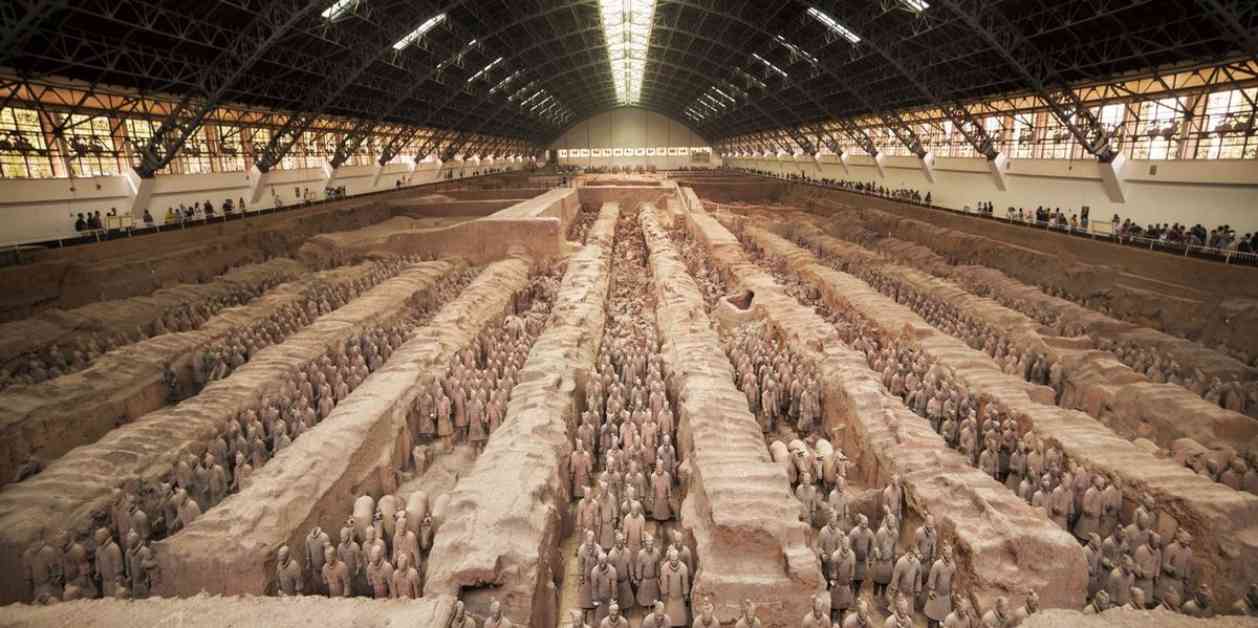China’s First Emperor’s Tomb: A Treasure Trove of Secrets
The tomb of Qin Shi Huang, China’s first emperor who reigned from 221 BC to 210 BC, remains one of the most intriguing archaeological mysteries of our time. Guarded by a terracotta army of soldiers and horses, the tomb was discovered by farmers in 1974 in the Shaanxi province of China. Since then, it has captured the imagination of historians, archaeologists, and curious minds around the world.
The discovery of the tomb was a groundbreaking moment in the field of archaeology, shedding light on the grandeur and complexity of ancient Chinese civilization. The terracotta army, consisting of thousands of life-sized soldiers and horses, stands as a testament to the power and wealth of the Qin Dynasty. Each figure is unique, reflecting the individuality and skill of the craftsmen who created them.
However, despite decades of research and exploration, the tomb itself remains unopened. Archaeologists have been hesitant to disturb the resting place of Qin Shi Huang, fearing the potential consequences of unlocking its secrets. According to historical accounts, the tomb is said to be filled with rare artifacts, treasures, and even booby traps designed to deter intruders.
The writings of Chinese historian Sima Qian, dating back to 100 years after Qin Shi Huang’s death, provide a glimpse into the opulence of the tomb. Describing palaces, scenic towers, and a treasure trove of riches, Sima Qian’s accounts paint a vivid picture of the grandeur that awaits inside the tomb. However, it is the mention of crossbows, arrows, and flowing mercury that has sparked the most intrigue and speculation.
The idea of crossbows and arrows primed to shoot at anyone who enters the tomb is both fascinating and chilling. The use of mercury to simulate rivers, seas, and other natural elements adds another layer of mystery to the tomb. As researchers have delved deeper into the tomb’s secrets, they have uncovered evidence of liquid mercury seeping through cracks in the structure, raising concerns about the potential dangers of opening the tomb.
In a 2020 paper, scientists highlighted the volatile nature of mercury and its potential impact on the tomb’s contents. The use of non-invasive techniques to explore the tomb has been considered, but as of now, no definitive plans have been put in place. The fear of disturbing the delicate balance of the tomb, as well as the risks associated with mercury exposure, has led archaeologists to proceed with caution.
Despite the challenges and uncertainties surrounding the tomb of Qin Shi Huang, researchers remain determined to unlock its secrets. The allure of discovering rare artifacts, ancient treasures, and perhaps even the remains of the emperor himself drives their quest for knowledge. As technology advances and new methods of exploration emerge, the possibility of finally opening the tomb becomes more tangible.
Exploring the Legacy of Qin Shi Huang
Qin Shi Huang, also known as Ying Zheng, was a visionary leader who unified China and established the Qin Dynasty. His reign was marked by significant achievements, including the construction of the Great Wall of China and the standardization of weights, measures, and currency. However, it was his quest for immortality and eternal power that led to the creation of his elaborate tomb.
The tomb of Qin Shi Huang was designed to be a reflection of his greatness and a symbol of his eternal rule. The terracotta army, with its lifelike figures and intricate details, was meant to accompany him into the afterlife and protect him in death. The inclusion of treasures, artifacts, and booby traps further underscored the emperor’s desire to maintain control even in the afterlife.
As researchers continue to study the tomb and its contents, they gain valuable insights into the life and legacy of Qin Shi Huang. The discovery of new artifacts, the analysis of ancient texts, and the use of advanced technology all contribute to our understanding of this enigmatic figure. Each new revelation brings us closer to unraveling the mysteries of his reign and the secrets hidden within his tomb.
The Future of Qin Shi Huang’s Tomb
The question of whether or not to open the tomb of Qin Shi Huang remains a topic of debate among archaeologists, historians, and cultural experts. While some argue that the risks outweigh the potential rewards, others believe that the knowledge gained from exploring the tomb could far outweigh any potential dangers. As technology continues to advance, new opportunities for non-invasive exploration may present themselves, offering a safer and more controlled approach to unlocking the tomb’s secrets.
Regardless of the outcome, the tomb of Qin Shi Huang will continue to captivate and inspire generations to come. Its significance in Chinese history, its cultural importance, and its potential to reshape our understanding of the past make it a treasure trove of knowledge waiting to be unearthed. As researchers strive to balance the preservation of history with the pursuit of discovery, the legacy of Qin Shi Huang and the mysteries of his tomb will endure as a testament to the enduring power of ancient China.













